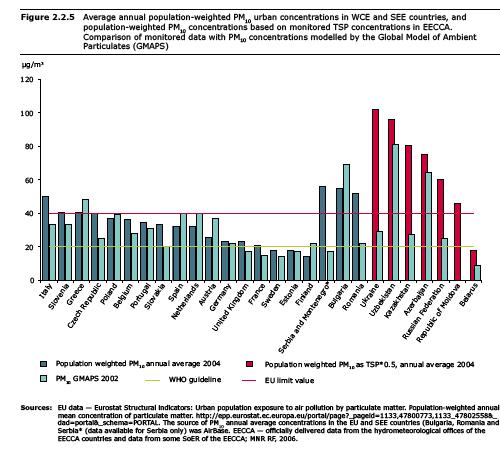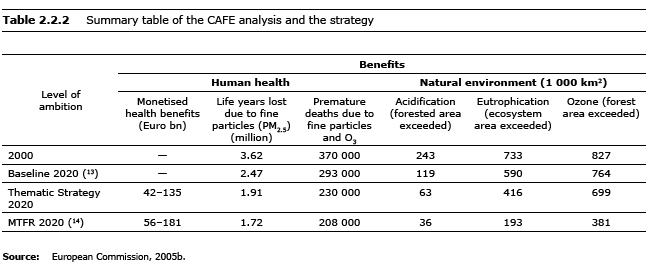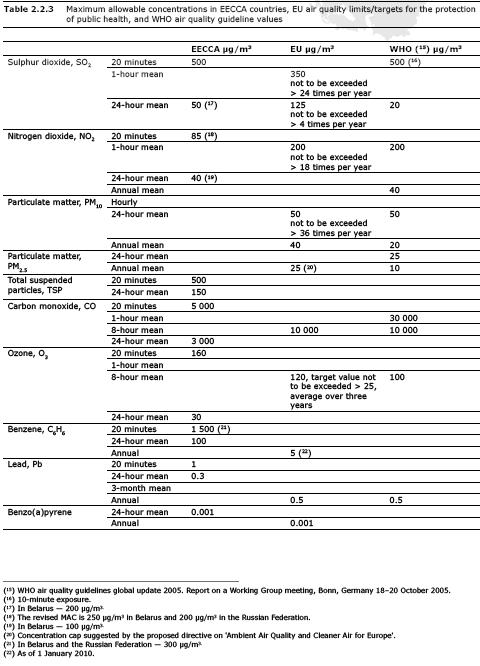This from the report, ‘Europe’s environment — The fourth assessment’, which was presented in Belgrade, Serbia, at the opening session of the sixth ministerial conference of the ‘Environment for Europe’ process held under the auspices of the United Nations Economic Commission for Europe (UNECE).
The latest in a series of assessments of the pan-European environment published by the EEA over the past 15 years, the report assesses environmental progress in 53 countries — an area with a total population of more than 870 million people. The region includes: Eastern Europe, Caucasus and Central Asia (EECCA), South East Europe (SEE), as well as Western and Central Europe (WCE).
In the Russian Federation, an assessment of the impact of outdoor air pollution on public health, based on the 1993 and 1998 monitoring data, showed that 15–17 % of total annual mortality (up to 219 000–233 000 premature deaths) might be caused by fine particles (Reshetin and Kazazyan,2004).
In Ukraine and the Russian Federation, estimates of health losses from urban air pollution based on TSP monitoring data in Ukraine indicated considerable health and mortality consequences. In Ukraine, the low (conservative) estimate was 27 000 excess
deaths annually, and for the Russian Federation the estimate was about 85 000 excess deaths (Strukova et al., 2006).
As estimated under Transport Health and Environment Pan-European Programme (THE PEP),
air pollution from road transport affects the health of about 10–15 million urban Russian residents. In the large city centres, road transport may account for more than 80 % of total air emissions. In 2002, the average annual concentrations of harmful pollutants exceeded maximum permissible levels in 201 Russian cities, home to 61.7 % of the urban population. An estimated 22 000–28 000 additional deaths in
the Russian Federation were attributable to road transport-related emissions in people over the age of 30 (ECMT, 2004).
The WHO project ‘Comparative Quantification of Health Risks’ has estimated the health impacts of outdoor air pollution in major cities (population > 100 000 people) of the world grouped in 14 regions, including EUR-C, consisting mostly of
EECCA countries. The annual impact of air pollution by particulate matter for this region was estimated at 46 000 premature deaths and 320 000 years of life lost (WHO, 2004b).Excess concentrations of ozone are thought to hasten the deaths of up to 20 000 people in the EU each year (Watkiss et al., 2005). Further, ozone is responsible for people vulnerable to its effects having to take medication for respiratory conditions
for a total of 30 million person-days a year. Some studies also suggest that long-term exposure to ozone reduces lung function growth in children
.

Achieving the lower levels of particulates (mainly from coal power plants and automobiles) would save thousands of lives per year

France which has 80% power from nuclear energy has superior air quality

the worse air quality is from particulates and ozone, then the more people die, the more money is lost (many billions per year) and the more the environment is destroyed

Targets for good public health for different kinds of air pollution, all of these things are mainly from coal power plants and automobiles and trucks

Brian Wang is a Futurist Thought Leader and a popular Science blogger with 1 million readers per month. His blog Nextbigfuture.com is ranked #1 Science News Blog. It covers many disruptive technology and trends including Space, Robotics, Artificial Intelligence, Medicine, Anti-aging Biotechnology, and Nanotechnology.
Known for identifying cutting edge technologies, he is currently a Co-Founder of a startup and fundraiser for high potential early-stage companies. He is the Head of Research for Allocations for deep technology investments and an Angel Investor at Space Angels.
A frequent speaker at corporations, he has been a TEDx speaker, a Singularity University speaker and guest at numerous interviews for radio and podcasts. He is open to public speaking and advising engagements.

